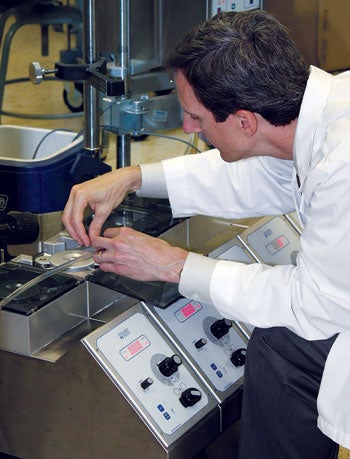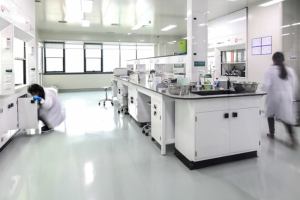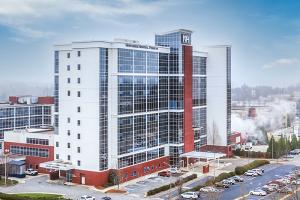Maintenance alternatives
About this seriesThis series of tutorial articles is a joint project of the American Society for Healthcare Engineering and Health Facilities Management. |
The Centers for Medicare & Medicaid Services (CMS) recently shifted its policy on preventive maintenance, allowing health care facilities to implement alternative maintenance programs in some instances.
This change, which clarifies a previous CMS memo that required closer adherence to manufacturers' recommendations, will help health care organizations to keep facility and medical equipment maintained properly without spending resources unnecessarily.
It also reflects CMS's commitment to listen to those in the field about such issues, and to clarify positions when needed, says Chad Beebe, AIA, SASHE, American Society for Healthcare Engineering (ASHE) deputy executive director for advocacy.
"CMS heard the concerns and reviewed it," Beebe says. "Kudos to CMS for taking a more measured and data-driven approach to this topic. This process is changing for the better."
The CMS memo
On Dec. 2, 2011, CMS issued a Survey and Certification Group memo that specified restrictions in alternative maintenance programs. Under the memo, hospitals could adjust maintenance and testing frequencies in limited cases after a risk assessment, but could not implement alternative maintenance methods. The memo also stated that hospitals had to follow manufacturers' recommendations for all equipment "critical to patient health and safety" and any new equipment without a sufficient maintenance history.
The directive differed from the Joint Commission's process for preventive maintenance, which is risk-based and allows for flexibility. Many in the facility management field were disappointed with the 2011 memo, arguing that it would require more resources without improving patient safety.
ASHE worked with other groups, including the Joint Commission and the Association for the Advancement of Medical Instrumentation (AAMI), to respond to the memo. The Joint Commission created surveys to gather data from those responsible for equipment maintenance in hospitals. ASHE and AAMI met with CMS to deliver data on preventive maintenance and discuss the issue.
CMS also heard from those who opposed any changes to the 2011 memo, including several organizations involved in medical imaging and radiation therapy. These groups said that following manufacturer recommendations was important for promoting patient and user safety.
After considering the issue, CMS issued a clarifying memo on Dec. 20, 2013 (www.cms.gov/Medicare/Provider-Enrollment-and-Certification/SurveyCertificationGenInfo/Downloads/Survey-and-Cert-Letter-14-07.pdf). The new memo stated that hospital facilities, supplies and equipment "must be maintained to ensure an acceptable level of safety and quality," but allows for alternate equipment maintenance schedules and activities. The memo specifically notes that radiological and imaging equipment is not appropriate for alternate maintenance programs.
ASHE and AAMI applauded CMS for the updated memo. "CMS did its homework and appeared to listen to all of the input it received," AAMI President Mary Logan says in a Dec. 20, 2013, article posted on www.aami.org. "This is a much more responsible way to handle preventive maintenance," Beebe comments.
 |
| A biomedical engineer prepares to test a heart-lung bypass machine roller pump for flow accuracy. Photo courtesy of ECRI Institute |
Although the new memo allows for alternate equipment maintenance programs, there are several restrictions. Hospitals cannot adjust maintenance, inspection and testing frequencies for the following items:
- Medical laser devices;
- New equipment without a significant amount of maintenance history;
- Equipment required by federal or state laws or conditions of participation to be maintained according to manufacturers' recommendations, including all imaging and radiologic equipment.
For hospitals seeking to implement an alternate equipment maintenance program, there are several factors to consider.
Creating alternate programs
Hospitals that choose to use alternate maintenance procedures or schedules must follow CMS guidelines on alternate equipment management (AEM) programs. Hospitals have to develop, implement and document AEM programs to minimize risks.
According to guidelines given by CMS in its memo and accompanying draft guidance, all AEM programs must be based on generally accepted standards of practice [see sidebar, below]. Qualified personnel — whether they are hospital employees or contractors — are responsible for determining whether it is safe to use alternate maintenance schedules or techniques.
Draft guidance from CMS states that clinical or biomedical engineers and technicians would be considered qualified to decide whether medical equipment belongs in an AEM program, though people with additional knowledge or training may be required to determine whether highly complex equipment belongs in an AEM program. Facility management professionals — such as facility managers, directors of facilities and vice presidents of facilities — would be considered qualified to determine what facility equipment belongs in an AEM program.
In making the determination, hospitals must consider the typical risks associated with the equipment's use and should identify any equipment in the AEM program considered critical, such as biomedical or physical plant equipment that would post risks of serious injury or death if it failed.
CMS suggests the following questions to consider when a hospital is determining whether equipment should be part of an AEM program:
• Would a failure or malfunction of the device likely cause harm to a patient or staff member? Risks may be different depending on the situation (i.e., a miscalibrated scale in an adult outpatient clinic may not pose much risk, but a miscalibrated scale in a neonatal intensive care unit could have serious consequences).
• Are manufacturers' maintenance recommendations and the rationale for those recommendations available? If not, how does the hospital assess whether the AEM uses appropriate maintenance strategies? How can the hospital validate the effectiveness of its AEM methods?
• Are alternate devices or backup systems readily available in the event of equipment failure or malfunction?
• What is the incident history of similar equipment? What are the frequency and nature of previous failures and service requests? Do these data show that using an AEM strategy would not result in downgraded equipment performance?
Developing the program
To develop the AEM program, CMS allows hospitals to use information from a variety of sources, including nationally recognized organizations like ASHE and AAMI, manufacturers' recommendations, the hospital's own experience, or the experience of a third-party contractor who works for the hospital. Alternate maintenance approaches can be applied to groups of equipment or individual pieces.
According to CMS draft guidance, a hospital must document the following information for each type of equipment included in an AEM program:
• The types and levels of risks to patient or staff health and safety;
• Alternate maintenance activities and the rationale used to determine those activities as well as how its maintenance activities differ from manufacturer recommendations when available;
• Alternate maintenance frequencies that will be used and the rationale behind those frequencies (e.g., for very low-risk equipment, broad frequency ranges such as "every 12 to 24 months" may be appropriate);
• The date when AEM program maintenance activities were performed and any further actions required or taken;
• Documentation of any equipment failures — not including operator error — and whether there was harm to an individual.
Hospitals also must create policies and procedures to evaluate its AEM program. They should consider how equipment is evaluated to ensure that performance does not suffer and how malfunctioning incidents are investigated. They also should use performance data to determine whether they need to change their AEM programs.
CMS notes that all hospital and facility equipment — even equipment that is maintained according to manufacturer recommendations — should be listed in an inventory that includes a record of maintenance activities. This applies to equipment a hospital owns and leases. Hospitals using an AEM program must be able to identify which pieces of equipment on the inventory are included in the program and critical equipment (regardless of whether it is part of an AEM program) should be listed as such.
CMS gives hospitals flexibility in the way they show maintenance efficiency, but states that a well-designed equipment inventory contains the following information for all equipment:
- Unique identification number;
- Equipment manufacturer;
- Equipment model number;
- Equipment serial number;
- Description of the equipment;
- Location of equipment generally kept in one location;
- Identity of the department considered to "own" the equipment;
- Identification of the service provider;
- Acceptance data;
- Any additional information that could be useful for proper equipment management.
The survey process
In addition to providing direction for hospitals looking to establish or use AEM programs, the draft guidance from CMS also outlines survey procedures related to such programs. CMS surveyors interview personnel responsible for facility and medical equipment to determine if there is a complete inventory; whether equipment failures are occurring and causing problems; and whether the hospital has documented qualifications of those responsible for an alternate maintenance approach.
If a hospital is following manufacturer recommendations, surveyors select sample equipment from the inventory — including critical equipment that would pose a risk if it were to fail — to determine whether the hospital has manufacturer recommendations and whether maintenance is being performed according to those recommendations.
In hospitals that use an AEM program, surveyors look to see whether any ineligible equipment, such as diagnostic imaging equipment, is erroneously included in the AEM program. Surveyors also verify that the hospital has documented its maintenance activities and frequencies for all items in the program and that the facility evaluates the safety and effectiveness of its program. Surveyors select sample equipment — the majority of which is critical equipment that could pose risks in the event of failure — and determine whether maintenance is being performed according to the AEM program.
Surveyors ask responsible personnel to explain how the decision was made to include the equipment in the AEM program. Personnel also should be able explain the maintenance activities and frequencies for the sampled equipment, including sources of information they used to determine the AEM schedules or activities.
The full CMS memo and draft guidance, which is available online by searching for CMS S&C 14-07 at www.cms.gov, offers more information on this subject.
Deanna Martin is communications manager for ASHE. She can be reached at dmartin@aha.org.
Alternate maintenance resources
The Centers for Medicare & Medicaid Services (CMS) state in a Dec. 20, 2013, memo that any hospital wanting to use alternate equipment management (AEM) programs must develop, implement and maintain a documented AEM program to minimize risks. AEM programs must be based on "generally accepted standards of practice for facility or medical equipment maintenance."
CMS mentions two examples of guidelines for equipment maintenance that hospitals may find helpful:
• Guidelines for medical equipment maintenance programs can be found in the American National Standards Institute/Association for the Advancement of Medical Instrumentation (ANSI/AAMI) EQ 56, Recommended Practice for a Medical Equipment Management Program. This document specifies criteria medical equipment management programs should meet to minimize risks. The document costs $120 (or $60 for AAMI members) and is available at http://my.aami.org/store.
• Guidelines for physical plant equipment maintenance can be found in the American Society for Healthcare Engineering (ASHE) book Maintenance Management for Health Care Facilities. The document describes procedures for a cost-effective approach that provides maintenance levels needed to keep equipment operating properly, safely and economically. The book is $125 (or $95 for ASHE members) and is available at
www.ASHEstore.com.
Both resources are helpful to hospitals that plan to implement AEM programs. CMS also notes in its 2013 memo that it "welcomes the identification of other recognized sources of recommendations for facility and equipment maintenance."





